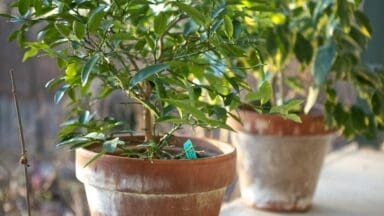
New research from Allianz UK (2,000 respondent UK Survey via 3Gem, June 2025) revealed that more than 67% of gardeners have been victims of plant theft, with 46% believing plant theft is on the rise in their neighbourhood. Peonies and Japanese Maple trees are reportedly on top the list of plants most likely to be stolen.
“Over the past few years the horticultural community says it has seen an increase in the number of plants that are being pinched from gardens. Owners of these common plants, flowers, shrubs and trees should take steps to protect their beloved plants this summer,” said the botanist, James Wong.
In a country of garden lovers and 38% of the research respondents ranking their plants as their most prized possessions with the average gardener reportedly paying as much as £300 on a single plant, rising plant theft is a worrying development. According to Allianz, 56% of us aren’t covered in home insurance for garden theft.
Sadly plant theft isn’t limited to domestic situations but also in botanic gardens, such as the Royal Botanic Gardens, Kew where every year plants are stolen from their living collections. Many of Kew’s rare or exotic plants are tempting targets for thieves who sell plants illegally – or even by disgraceful gardeners looking for a special plant for their collections. Famously, in 2014, a specimen of the world’s smallest and rarest waterlily, Nymphaea thermarum, was stolen from the Princess of Wales Conservatory. The thief was never found.
Matt Cox, Allianz UK Chief Claims Officer, said: “Millions of people enjoy gardening in the UK and a beautiful garden can take years of hard work and thousands of pounds to create. They are a labour of love for people and become a place of sanctuary for those who want somewhere to escape the hustle and bustle of everyday life. Plants theft can be heartbreaking for gardeners, particularly when the plants stolen have taken years to cultivate. The best defence against plant theft is vigilance and homeowners can use a series of security measures to deter thieves.”
Plants at risk from theft
- Japanese Maple Trees: At full maturity these can be worth thousands of pounds. Housing such precious specimens in a plant pot could put them at risk.
- Newly-Planted Trees: Trees such as magnolias often fall foul of burglaries when they’re young, as they can be easily stolen before the roots take hold.
- Peonies: Slow-growing and tricky to propagate, some rare forms can sell for over £200.
- Lemon Trees: Easily recognisable by their colourful fruit and costly to purchase makes them targets for opportunistic thieves.
- Tasmanian Tree Ferns: Opportunistic thieves can sneakily clip a cutting, as these can be worth as much as £100 for every foot they grow.
- Bonsai: Probably the most valuable plant in terms of resale value per kilo of weight. A 50-year-old bonsai could be worth £5,000.
- Windmill Palms: Often planted in pots and can retail for over £1000, making them a prime target for thieves.
- Olive Trees: These high value trees can live for hundreds of years, but often start life in small plant pots outside.
- Hydrangeas: The new generation of designer hydrangea varieties can retail for as much as £100.
- Variegated Monstera: Individual cuttings of this sold for thousands online during lockdown, and a metre-high specimen could still be worth more than £500.
Ex-police officer Dr. Leroy Logan MBE advises gardeners to pot plants with soil rather than compost, making them trickier for thieves to lift, and sow new lawns with seeds from scratch rather than with easy to swipe ready rolled turf. Logan also advises anchoring plants with cable ties and laying down (noisy) gravel paths near high value foliage.
According to Allianz UK, thieves are often opportunistic and go for quick wins. Making it more difficult to steal, such as storing valuable plants and garden ornaments in the back garden, keeping exotic plants out of public view, adding fencing, (thorny) shrubs, or trellis screening to reduce visibility can help keep the garden safe. Planting new trees is advised to take place in the dormant season so they are less likely to catch a thief’s eye. Also, a lesser known trick is to use a UV pen or plant-safe forensic liquid to mark valuables with your postcode, creating a trackable link should you ever need to produce proof of ownership. As one would with valuable household items, photographing rare plants, tools and ornaments can also prove to be an asset for the police if they need to get involved.
A rather sad state of affairs, especially in terms of the future of our already dwindling front gardens impacting neighbourhood appeal across the country, but better safe than sorry…

